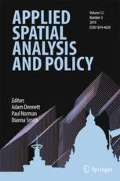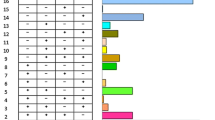Abstract
Research on internal migration age profiles is important for understanding the dynamics of a country’s population geography, creating accurate population estimates in non-census years, and smoothing migration age profiles for sub-national population projections. In the international literature, internal migration age profiles are often characterised as relatively stable over time and space, and consisting of gradual changes in migration intensities from one age to the next – as depicted by the widely-used model migration schedule. However, a few migration age profiles in Australia are known to exhibit highly age-specific ‘spikes’ related to movement to higher education institutions. This paper undertakes an investigation of inter-regional migration age profiles in Australia to determine the extent of the phenomenon. Data from the Australian 2011 Census are used to create inter-regional migration probabilities by single years of age, together with more specific probabilities describing university-bound and boarding school-bound migration. Migration age patterns at three spatial scales of region are examined. It is shown that university-bound age-specific spikes are present in the majority of regional in- and out-migration age profiles in Australia at either age 18 or 19. In many cases this results in the peak migration probability occurring at these ages. Boarding school-bound migration is less significant and present in a smaller proportion of regional migration age profiles. In preparing smoothed migration age profiles for sub-national population projections it is imperative to smooth out noise but retain these significant education-bound migration spikes. Further work is required to determine the optimum ways of smoothing these migration age profiles.








Similar content being viewed by others
References
Australian Bureau of Statistics (ABS) (2010) Australian Statistical Geography Standard (ASGS): Volume 1 – Main Structure and Greater Capital City Statistical Areas, July 2011. Catalogue No. 1270.0.55.001. Canberra: ABS
Bell, M. (1995). Internal Migration in Australia 1986–1991: Overview Report. Canberra: Australian Government Publishing Service.
Bell, M., Blake, M., Boyle, P., Duke-Williams, O., Rees, P., Stillwell, J., & Hugo, G. (2002). Cross-national comparison of internal migration: issues and measures. Journal of the Royal Statistical Society A, 165(3), 435–464.
Bernard, A., Bell, M., & Charles-Edwards, E. (2014). Life course transitions and the age profile of internal migration. Population and Development Review, 40(2), 213–239.
Blakers, R., Bill, A., Maclachlan, M., & Karmel, T. (2003). Mobility: Why Do University Students Move? Canberra: Department of Education, Science and Training.
Chiang, C. L. (1991). Competing risks in mortality analysis. Annual Review of Public Health, 12, 281–307.
Congdon, P. (2008). Models for Migration Age Schedules: A Bayesian Perspective with an Application to Flows between Scotland and England. In J. Raymer & F. Willekens (Eds.), International Migration in Europe: Data, Models and Estimates (pp. 193–205). Chichester: John Wiley & Sons.
De Beer, J. (2011). A new relational method for smoothing and projecting age specific fertility rates: TOPALS. Demographic Research, 24(18), 409–454.
De Beer, J. (2012). Smoothing and projecting age-specific probabilities of death by TOPALS. Demographic Research, 27(20), 543–592.
Department of Education, Training and Youth Affairs (DETYA) (2001) Higher Education Students Time Series Tables: Selected Higher Education Statistics. Canberra: DETYA. http://www.industry.gov.au/HigherEducation/HigherEducationStatistics/Pages/Library%20Card/Publications/2000TimeSeries.aspx accessed 22 June 2014
Department of Industry, Innovation, Science, Research and Tertiary Education (DIISRTE) (2012) 2011 Student Full Year. [Online statistical publication]. Canberra: DIISRTE. http://www.industry.gov.au/highereducation/HigherEducationStatistics/StatisticsPublications/Pages/2011StudentFullYear.aspx accessed 22 June 2014
Duke-Williams, O. (2009). The geographies of student migration in the UK. Environment and Planning A, 41(8), 1826–1848.
Flood, J., Maher, C., Newton, P., & Roy, J. (1991). The Determinants of Internal Migration in Australia. Melbourne: CSIRO.
Guardian Australia (2014). ‘Budget: university students to pay more with removal of caps on fees’ Guardian Australia [online]. http://www.theguardian.com/world/2014/may/13/budget-university-students-to-pay-more-with-removal-of-caps-on-fees, accessed 13th May 2014
Liaw, K., & Nagnur, D. N. (1985). Characterization of metropolitan and nonmetropolitan outmigration schedules of the Canadian population system, 1971–1976. Canadian Studies in Population, 12(1), 81–102.
Millington, J. (2000). Migration and age: The effect of age on sensitivity to migration stimuli. Regional Studies, 34(6), 521–533.
Mulder, C. H. (1993). Migration Dynamics: A Life Course Approach. Amsterdam: Thesis Publishers.
Norton, A. (2013). Mapping Australian higher education. 2013 Version. Melbourne: Grattan Institute.
Office for National Statistics (ONS). (2013). Analysis of internal migration research series, years ending June 2009 to June 2011. London: ONS.
Openshaw, S. (1984). The Modifiable Area Unit Problem. Norwich: GeoBooks.
Plane, D. A., & Heins, F. (2003). Age articulation of US inter-metropolitan migration flows. The Annals of Regional Science, 37(1), 107–130.
Rees, P. (1986). Choices in the construction of regional population projections. In R. Woods & P. Rees (Eds.), Population Structures and Models: Developments in Spatial Demography (pp. 126–159). London: Allen and Unwin.
Rees, P. (1997). Problems and solutions in forecasting geographical populations. Journal of the Australian Population Association, 14(2), 145–166.
Rees, P., Bell, M., Duke-Williams, O., & Blake, M. (2000). Problems and solutions in the measurement of migration intensities: Britain and Australia compared. Population Studies, 54(2), 207–222.
Rogers, A., Little, J., & Raymer, J. (2010). The Indirect Estimation of Migration. Dordrecht: Springer.
Rogers, A. (1975). Introduction to Multiregional Mathematical Demography. New York: John Wiley.
Rogers, A., & Castro, L. J. (1981). Model Migration Schedules. Research Report RR-81-30. Laxenburg: International Institute for Applied Systems Analysis.
Rogers, A., Racquillet, R., & Castro, L. J. (1978). Model migration schedules and their applications. Environment and Planning A, 10(5), 475–502.
Rowland, D. T. (1979). Internal Migration in Australia. Canberra: ABS.
Schofer, E., & Meyer, J. W. (2005). The worldwide expansion of higher education in the twentieth century. American Sociological Review, 70(6), 898–920.
Wilson, T. (2010). Model migration schedules incorporating student migration peaks. Demographic Research, 23(8), 191–222. www.demographic-research.org/.
Wilson, T. (2011). Modelling with NEWDSS: producing State, regional and local area population projections for New South Wales. In J. Stillwell & M. Clarke (Eds.), Population Dynamics and Projection Methods: Essays in Honour of Philip Rees (pp. 61–97). Dordrecht: Springer.
Author information
Authors and Affiliations
Corresponding author
Rights and permissions
About this article
Cite this article
Wilson, T. The impact of education-bound mobility on inter-regional migration age profiles in Australia. Appl. Spatial Analysis 8, 371–391 (2015). https://doi.org/10.1007/s12061-014-9124-0
Received:
Accepted:
Published:
Issue Date:
DOI: https://doi.org/10.1007/s12061-014-9124-0




